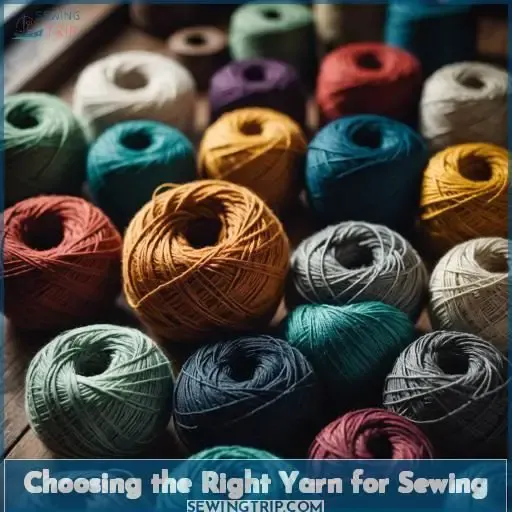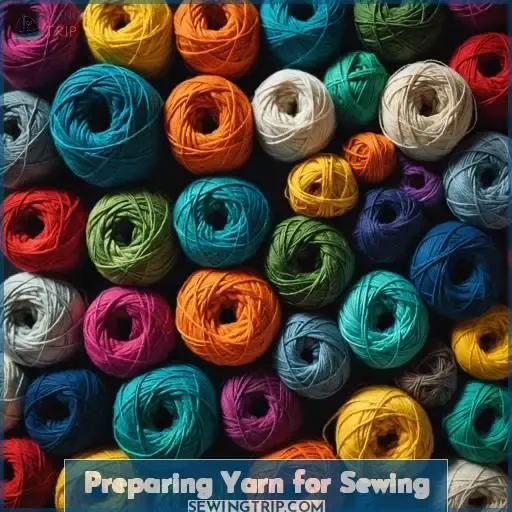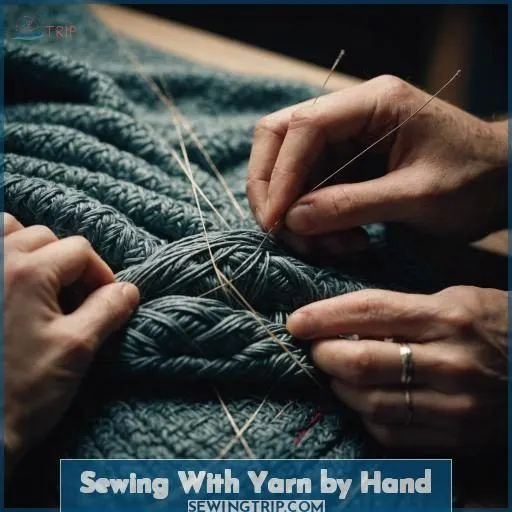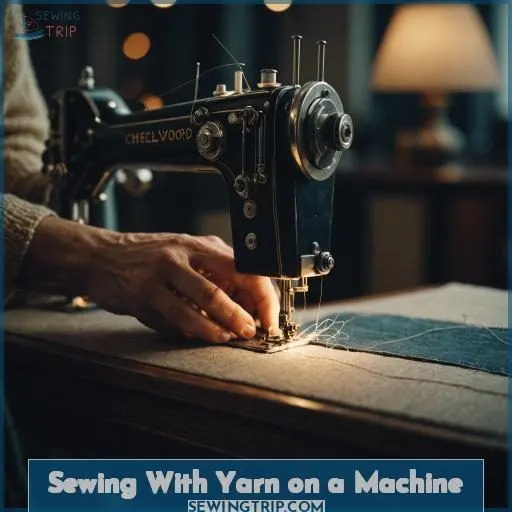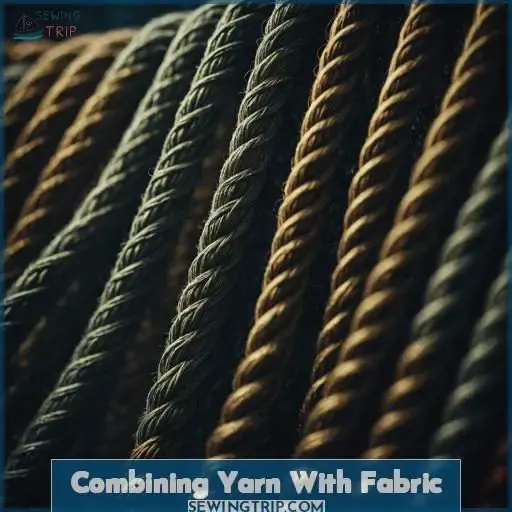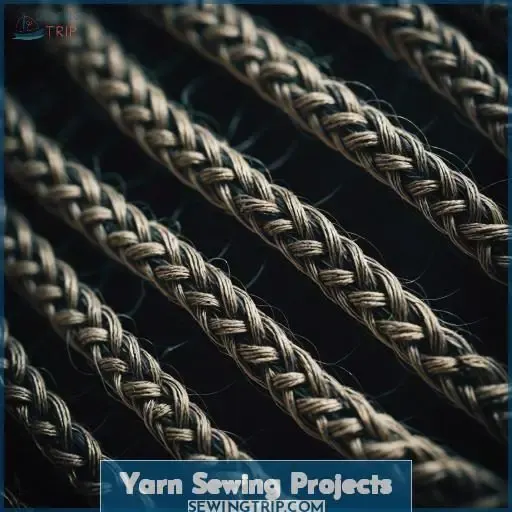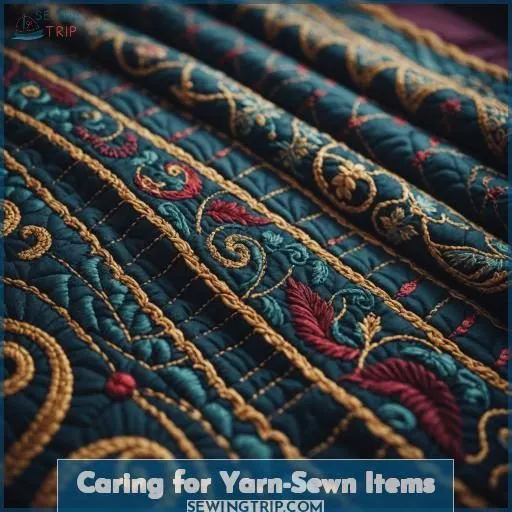This site is supported by our readers. We may earn a commission, at no cost to you, if you purchase through links.
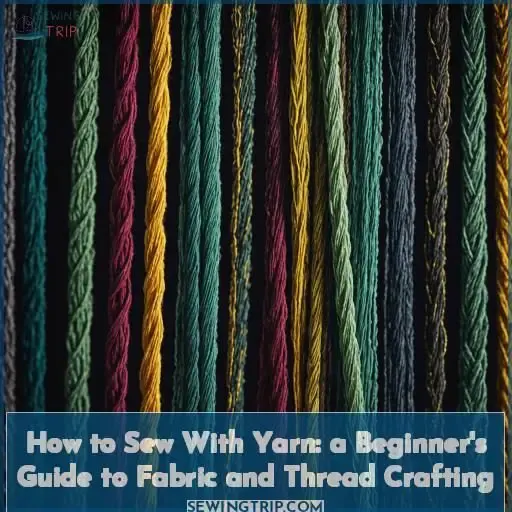 To sew with yarn, commence by selecting the suitable weight and texture for your venture.
To sew with yarn, commence by selecting the suitable weight and texture for your venture.
Prepare the yarn by smoothing strands, safeguarding ends, and utilizing a needle threader for convenient threading.
Master hand-sewing methods such as embroidery stitches and securing yarn on the reverse side.
Modify your machine’s tension and configurations for thick thread, investigating techniques like couching and bobbin work.
Express your creativity by integrating yarn with fabric through appliqué, quilting, and adornments.
Enhance garments with fringe, tassels, and pom-poms fabricated from yarn.
Embrace the flexibility of this medium, and delve into our extensive guide to fabric and thread crafting with yarn.
Table Of Contents
Key Takeaways
- Choose the right yarn weight and texture for your project, considering your sewing machine’s capabilities. Thicker yarns may require tension adjustments or creative techniques like couching.
- Prepare the yarn by flattening strands, securing ends, and using a needle threader for easy threading. Master hand-sewing methods like embroidery stitches and securing yarn on the reverse side.
- Combine yarn with fabric through appliqué, quilting, and embellishments to express your creativity. Enhance garments with fringe, tassels, and pom-poms fabricated from yarn.
- Properly care for sewn yarn items by hand washing in cold water, air drying, and mending any worn or damaged sections with matching yarn and a needle. Store in a cool, dry place away from direct sunlight and moisture.
How to Sew With Yarn?
To sew with yarn, you’ll need to choose the right yarn weight and texture for your project, thread a yarn needle, and secure the ends. Sewing with yarn can be done by hand using basic stitches or on a sewing machine with adjustments to the settings.
Choosing the Right Yarn for Sewing
To craft fabric projects with a distinctive flair, carefully consider your yarn’s weight – thicker options lend themselves to bold statements, while finer threads allow for delicate detailing. The texture also plays a pivotal role; smooth yarns create sleek surfaces, while textured varieties add intriguing depth and dimension.
Selecting Yarn Weight Based on Project
Selecting the appropriate yarn thickness is essential for your sewing endeavor.
Finer weights are suitable for delicate items.
While thicker weights enhance texture and appeal for larger pieces.
Take into account your sewing machine’s abilities as well.
Certain machines can accommodate thicker threads.
But exceeding specifications may result in tension difficulties.
Modify settings as necessary for ideal outcomes.
When using bulky yarns for a cozy handcrafted blanket.
Considering Yarn Texture and Thickness
When selecting yarn for your sewing projects, consider the texture and thickness that best suits your needs. Smooth yarns like cotton or polyester are ideal for clean lines, while textured yarns like boucle or eyelash add visual interest. Thicker yarns like chunky wool create cozy blankets, while thinner yarns like embroidery floss allow for intricate details. Choose a yarn that aligns with your project’s purpose and your personal style preferences.
- Smooth yarns create clean lines
- Textured yarns add visual interest
- Thick yarns make cozy blankets
- Thin yarns allow for details
Matching Yarn to Sewing Machine Capabilities
When sewing with yarn, consider your machine’s limitations. Thicker yarns may require tension adjustments or creative techniques like couching. Consult your manual for thread compatibility. With the right yarn and a little experimentation, you can create unique projects without special tools. Follow the yarn weight recommendations and adjust your stitches for best results when sewing with yarn.
Preparing Yarn for Sewing
With yarn as your sewing medium, threading the needle requires a gentle touch and a bit of ingenuity.
Flatten the strands with hairspray or moisture, or fashion a stiff point using paper or thread conditioner for easier passage through the eye.
Once threaded, control those wispy ends by tying a secure knot, applying a dab of fray preventer, or simply searing the tips to prevent premature unraveling.
Threading a Yarn Needle
Threading a yarn needle is a breeze with these tips!
Prepare the yarn end by taping paper around it, cutting it to a point, and spraying with hairspray to flatten strands.
Choose the right needle size for your yarn weight.
Insert the yarn through the eye, using a needle threader if needed.
With a little practice, you’ll be sewing with yarn like a pro!
Using a Needle Threader
Threading yarn through a needle’s eye can be tricky, but a needle threader makes it a breeze! Simply place the threader through the needle’s eye, feed the yarn through the threader’s loop, and gently pull it back through the eye. Works like magic for any needle size or yarn type!
Securing Yarn Ends
Securing yarn ends is essential for a tidy, lasting finish. Bind the tail to fasten the thread, then stitch back a few times to strengthen. Cut excess yarn, leaving a short tail. For added security, apply a touch of fabric glue or clear nail polish to the knot. Perfecting this step guarantees your yarn sewing projects survive the test of time.
- Bind the tail to fasten the thread
- Stitch back a few times to strengthen
- Cut excess yarn, leaving a short tail
- Apply fabric glue or nail polish to the knot for added security
- Perfecting this step guarantees your yarn sewing projects survive the test of time
Sewing With Yarn by Hand
With yarn sewing, you’ll create visually intriguing and textured stitches by mastering hand-sewing techniques that transform ordinary fabric into extraordinary artistry. Embrace the unique qualities of yarn – its thickness, texture, and malleability – as you explore decorative stitches and finishing methods that accentuate your handmade creations.
Basic Hand Sewing Techniques
Sewing with yarn by hand allows you to create basic stitches and appliqué techniques for embellishing fabric. Use a blunt needle to push yarn through the material, alternating between the front and back. Secure the ends with small stitches on the reverse side. Experiment with simple embroidery options and decorative stitching to add texture and interest to your projects.
Creating Decorative Stitches
Expand your imagination by embroidering with yarn! Stitch intricate designs, from delicate flowers to bold geometric patterns. Explore different stitches such as the French knot, lazy daisy, and herringbone. Yarn macrame and jewelry add a distinctive flair to any outfit. Craft whimsical tassels to embellish pillows, bags, or even your keys. The possibilities are boundless when you stitch with yarn!
Finishing and Securing Stitches
To finish your yarn stitches, tie off with a secure knot on the back of the fabric. Trim excess yarn, leaving a 1-inch tail. For extra durability, apply a dab of fabric glue to the knot. Maintain proper thread tension throughout to prevent puckering. With practice, you’ll master the art of embroidered yarn embellishments that last.
Sewing With Yarn on a Machine
When sewing with yarn on a machine, you’ll need to adjust settings to accommodate the thicker thread. Techniques like couching and bobbinwork, along with tension adjustments, will help you achieve professional-looking results with this unconventional material.
Adjusting Machine Settings for Thick Thread
Sewing with thick yarn on a machine requires adjusting settings. Check your machine’s compatibility with heavy threads. Increase tension to prevent puckering. Experiment with tension adjustments until you achieve the perfect stitch. Troubleshoot issues like skipped stitches or thread breakage by fine-tuning tension. With some trial and error, you’ll master sewing with yarn on your machine.
Techniques Like Couching and Bobbinwork
Couching and bobbinwork allow you to sew with yarn on a machine.
Couching involves stitching yarn onto fabric using a zigzag stitch.
Bobbinwork uses a specialized bobbin case to sew yarn from the underside.
Both techniques require adjusting machine settings for thick thread.
Free-motion stitching also works, but the yarn may bunch up.
Experiment with different machine settings to achieve the desired look.
Troubleshooting and Tension Adjustments
When sewing with yarn on a machine, tension adjustments are essential. Modify thread tension according to yarn thickness. Choose a needle suitable for your fabric. For bobbinwork, wind yarn freely on the bobbin. Verify that the fabric can withstand the weight of the yarn without wrinkling. With some experimentation, you’ll become proficient in sewing with yarn on your machine.
- Modify tension adjustments for yarn thickness
- Choose needle compatible with fabric
- Wind bobbin loosely for bobbinwork
- Verify fabric can handle yarn weight
Combining Yarn With Fabric
Take your textile crafting to new heights by adorning fabrics with vibrant yarn accents. Elevate quilts, garments, and home decor through thoughtful yarn embroidery, appliqué techniques, and creative embellishments that infuse color and texture.
Appliqué and Embroidery Techniques
Yarn embroidery and appliqué add eye-catching texture to fabric.
Wrap yarn around a needle to create raised designs.
Stitch yarn shapes onto fabric for appliqué.
Experiment with different yarn weights and textures for unique effects.
Combine yarn embellishment with traditional embroidery stitches.
Thread wrapping creates intricate patterns.
Yarn appliqué works well on pillows, bags, and clothing.
Embrace yarn’s versatility to elevate your fabric projects.
Incorporating Yarn Into Quilting
Quilting with yarn adds texture, color, and interest to your projects. Experiment with yarn dyeing, painting, or blending to create unique effects. Spin your own yarn for a personal touch. Felt yarn onto fabric for a whimsical look. Couching yarn onto quilt tops or incorporating it into appliqué designs elevates your quilting to an art form. Let your creativity shine!
Yarn Embellishments on Garments
Yarn embellishments on garments add a unique and eye-catching touch to your wardrobe. Experiment with:
- Yarn fringe on the edges of scarves, sleeves, or hems
- Yarn tassels as closures or decorations on jackets and bags
- Yarn pompoms on hats, mittens, or the ends of zippers
- Yarn buttons for a whimsical and handmade look
Unleash your creativity and let yarn transform your garments into one-of-a-kind masterpieces.
Yarn Sewing Projects
Ignite your imagination with yarn sewing projects that infuse whimsical charm into your home decor and personal style. From yarn-enveloped wreaths animating your entryway to vibrant yarn-bedecked pillows gracing your living space, these artistic pursuits beckon you to explore texture, color, and innovation.
Yarn-wrapped Wreaths and Wall Hangings
Unlock your creativity by crafting exquisite yarn-wrapped wreaths and wall hangings! Explore diverse yarn hues, textures, and designs to create one-of-a-kind pieces that reflect your flair. Tinge your own yarn for a bespoke touch, and maintain it in chic storage solutions. Adorn your creations with tassels, pom-poms, or elaborate weaving patterns for an extra special touch.
| Yarn Dyeing | Yarn Storage | Yarn Organization |
|---|---|---|
| Tailor your yarn colors to complement any decor | House yarn in transparent containers for effortless visibility | Mark containers with yarn type, hue, and quantity |
| Employ natural dyes for an eco-conscious option | Utilize yarn winders and swift for organized storage | Arrange by color, weight, or fiber type for swift access |
Yarn-embellished Pillows and Blankets
Elevate your pillows and blankets with yarn embellishments! Choose yarn weight and texture wisely, considering machine compatibility. Hand sew decorative stitches for a personal touch. Imagine:
- Cozy blankets with chunky yarn borders
- Pillows adorned with yarn pom-poms
- Quilts enhanced by yarn-wrapped appliqués
- Throws spruced up with yarn tassels
Unleash your creativity and transform your home decor with yarn-embellished pillows and blankets!
Yarn-accented Clothing and Accessories
Yarn embellishments elevate accessories, adding texture and unique patterns. Stitch yarn onto fabric for a handcrafted touch. Experiment with different yarn weights and colors to create eye-catching designs. Incorporate yarn into belts, bags, and jewelry for a trendy, personalized look. Embrace the versatility of yarn to make your accessories stand out.
| Yarn Weight | Fabric Texture | Embellishment Idea | Difficulty Level |
|---|---|---|---|
| Bulky | Denim | Yarn-wrapped belt | Intermediate |
| Worsted | Leather | Yarn-accented cuff | Beginner |
| Fingering | Felt | Yarn-embroidered brooch | Advanced |
| Lace | Silk | Yarn-tasseled earrings | Intermediate |
Caring for Yarn-Sewn Items
You’ve meticulously crafted and stitched your yarn-adorned creation, now guarantee its endurance with appropriate maintenance; gently handwash in lukewarm water when necessary, keep yarn ends trimmed tidily to avert unraveling, and capably mend any worn or damaged sections with matching yarn and a needle for a rejuvenated, vibrant appearance.
Washing and Drying Considerations
Caring for your yarn-sewn creations is a breeze with these simple tips.
To prevent shrinkage, always check yarn care labels and use cold water when hand washing.
For machine washing, use a gentle cycle and mild detergent.
Air drying is best, but if machine drying is necessary, use a low heat setting.
With proper care, your yarn projects will stay looking fabulous for years to come.
Preventing Yarn From Unraveling
To prevent yarn from unraveling, store it properly by winding it into balls or skeins. Use knotting techniques like the slip knot to secure ends. Experiment with yarn dyeing and blending to create unique colors and textures. Proper storage and finishing techniques will keep your yarn-sewn projects looking their best for years to come.
Repairing Worn or Damaged Areas
When your yarn-sewn creations show signs of wear, don’t fret! Mending is a breeze with a few simple techniques. Use yarn or thread for reinforcement, darn holes, or patch damaged areas. Embrace the imperfections – they add character! With a little love and care, your beloved items will continue to bring joy for years to come.
- Reinforce weak spots with yarn or thread
- Darn holes using a needle and yarn
- Patch damaged areas with fabric scraps
Frequently Asked Questions (FAQs)
Can I use yarn in a serger machine?
A stitch in time saves nine, they say – using thick yarn on a serger is risky business. Stick to needles and thread for the smoothest sail through your sewing projects. Sergers aren’t built to accommodate bulky materials like yarn.
How do I prevent yarn from fraying?
To stop yarn fraying, apply clear nail polish or fabric glue to the ends. You can also burn the tips quickly with a lighter for a melted, sealed finish.
What is the best way to store sewn yarn items?
You’ll want to store sewn yarn items in a cool, dry place away from direct sunlight and moisture. Consider using acid-free boxes or breathable fabric containers to prevent color fading or fiber damage.
Can I dye yarn after its been sewn?
You’d want to dye yarn before sewing. Dying after could bleed colors and leave an uneven finish. But, strategically dyeing sections post-sewing opens some creative possibilities for unique patterns and gradients.
How do I remove yarn stitches from fabric?
Like extracting a stubborn weed’s roots, use sharp embroidery scissors to gently snip each stitch. Patiently work your way across, freeing yarn from fabric’s woven embrace – a careful but rewarding task.
Conclusion
Ultimately, sewing with yarn unlocks a captivating sphere of options. With over 60% of artisans incorporating yarn into their textile endeavors, mastering this multifaceted medium empowers you to infuse singular textures and ornamentation. Delve into the artistry of sewing with yarn, experimenting with manual and mechanical methods to craft exceptional creations that embody your distinctive aesthetic.

